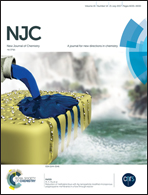Xanthine sensor development based on ZnO–CNT, ZnO–CB, ZnO–GO and ZnO nanoparticles: an electrochemical approach†
Abstract
The wet-chemical method was used to prepare various ZnO coated carbon nanotube nanocomposites (ZnO–CNT NCs), ZnO coated carbon black (ZnO–CB), ZnO coated graphene oxide (ZnO–GO), and ZnO nanoparticles (NPs) in a higher pH medium (pH > 10). The NCs are completely characterized in detail using various conventional methods, such as XPS, UV/vis, FT-IR, SEM, TEM and XRD. A glassy carbon electrode (GCE) with the NCs was fabricated and developed to be a selective xanthine (Xan) chemical sensor using a simple and reliable electrochemical I–V method. The NCs were used with a coating agent on a flat GCE with binders (5% nafion) to produce a thin film sensor that has a faster response towards selected xanthine compounds using electrochemical methods. The xanthine sensor exhibited higher sensitivity, large dynamic concentration ranges and higher stability. The sensitivity and detection limit were calculated and obtained as 59.14 μA cm−2 mM−1 and 0.16 nM (SNR of 3), respectively, for a ZnO–CNT NCs/Nafion/GCE assembly. Furthermore, the highest electrochemical performance towards selective Xan is exhibited by ZnO–CNT NCs/Nafion/GCE compared to ZnO NPs, ZnO–CB NCs, and ZnO–GO NCs. Finally, this approach was used for detecting and quantifying Xan in real samples and satisfactory results were obtained.



 Please wait while we load your content...
Please wait while we load your content...